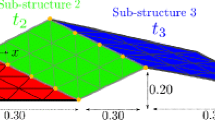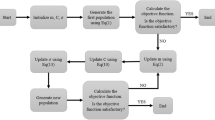Abstract
This paper is intended to present a method for the localization and evaluation of damage in plates based on the changes in natural frequencies and mode shapes of the damaged plate using an optimization approach. The colonial competitive algorithm is employed to detect damage (or damages) in plates by optimizing a damage function. The performance of the proposed method is demonstrated by implementing the technique to two examples; a shear wall and a four-fixed supported plate with and without modal data noise including one or a large number of damages. The results confirm the applicability and efficiency of the presented method in detecting damage localization and quantification in the shear walls. Furthermore, the proposed method is implemented to the four-fixed supported plate aimed at demonstrating the high sensitivity of the proposed method in quantitative estimation of damaged plate structures. Finally, the reliability of the presented method is explored through the comparison of the obtained results and those of the other methods. It is concluded that the proposed method can be viewed as a powerful and robust method for structural damage detection in plate structures.
Similar content being viewed by others
References
Doebling, S.W., Farrar, C.L., Prime, M.B., Shevitz, D.W.: Damage identification and health monitoring of structural and mechanical systems from changes in their vibration characteristics: a literature review, Los Alamos National Laboratory Report, LA-13070-MS (1996)
Lee E.-T., Eun H.-C.: Damage detection of damaged beam by constrained displacement curvature. J. Mech. Sci. Technol. 22(6), 1111–1120 (2008)
Bagheri A., Ghodrati Amiri G., Seyed Razaghi S.A.: Vibration-based damage identification of plate structures via curvelet transform. J. Sound Vib. 327, 593–603 (2009)
Wang Q., Deng X.: Damage detection with spatial wavelets. Int. J. Solids Struct. 36, 3443–3468 (1996)
Yan Y.J., Yam L.H.: Online detection of crack damage in composite plates using embedded piezoelectric actuators/sensors and wavelet analysis. Compos. Struct. 58, 29–38 (2002)
Douka E., Loutridis S., Trochidis A.: Crack identification in plates using wavelet analysis. J. Sound Vib. 270, 279–295 (2004)
Rucka M., Wilde K.: Application of continuous wavelet transform in vibration-based damage detection method for beams and plates. J. Sound Vib. 297, 536–550 (2006)
Fan W., Qiao P.: A 2-D continuous wavelet transform of mode shape data for damage detection of plate structures. Int. J. Solids Struct. 46, 4379–4395 (2009)
Perera R., Torres R.: Structural damage detection via modal data with genetic algorithms. J. Struct. Eng. ASCE 132(9), 1491–1501 (2006)
Chou J.H., Ghaboussi J.: Genetic algorithm in structural damage detection. Comput. Struct. 79(14), 1335–1353 (2001)
Yun G.J., Ogorzalek K.A., Dyke S.J., Song W.: A Two-stage damage detection approach based on subset selection and genetic algorithms. Smart Struct. Syst. 5(1), 1–21 (2009)
Rus G., Lee S.Y., Chang S.Y., Wooh S.C.: Optimized damage detection of steel plates from noisy impact test. Int. J. Numer. Meth. Eng. 68(7), 707–727 (2006)
Song W., Dyke S.J., Yun G.J., Harmon T.: Improved damage localization and quantification using subset selection. J. Eng. Mech. ASCE 135(6), 548–560 (2009)
Atashpaz-Gargari, E., Lucas, C.: Imperialist Competitive Algorithm: An Algorithm for Optimisation Inspired by Imperialistic Competition IEEE Congress on Evolutionary Computation (2007)
Rajabioun R., Atashpaz-Gargari E., Lucas C.: Colonial competitive algorithm as a tool for Nash equilibrium point achievement. Lect. Notes. Comput. Sci 5073, 680–695 (2008)
Atashpaz-Gargari E., Hashemzadeh F., Rajabioun R., Lucas C.: Colonial competitive algorithm, a novel approach for PID controller design in MIMO distillation column process. Int. J. Intell. Comput. Cybern. 1(3), 337–355 (2008)
Dennis, J.E. Jr.: Nonlinear Least-Squares. In: Jacobs, D. (ed.) State of the Art inNumerical Analysis, pp. 269–312. Academic Press, London (1977)
Author information
Authors and Affiliations
Corresponding author
Rights and permissions
About this article
Cite this article
Nicknam, A., Hosseini, M.H. Structural damage localization and evaluation based on modal data via a new evolutionary algorithm. Arch Appl Mech 82, 191–203 (2012). https://doi.org/10.1007/s00419-011-0548-6
Received:
Accepted:
Published:
Issue Date:
DOI: https://doi.org/10.1007/s00419-011-0548-6




